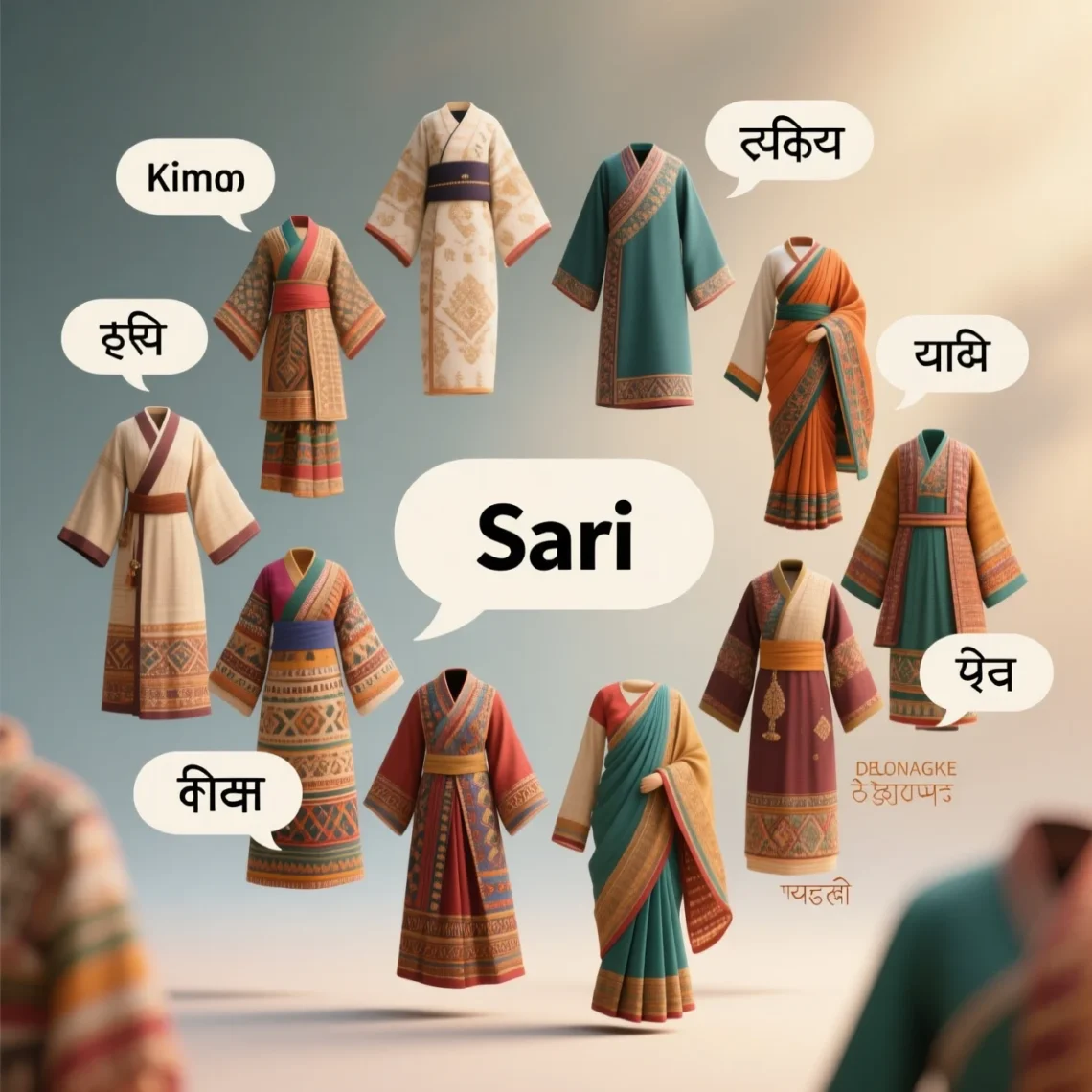Picture a vibrant market in Marrakech, where a vendor proudly displays a “djellaba,” the flowing robe that defines Moroccan elegance. The word for “clothing” carries a universal thread, weaving together identity, tradition, and creativity across cultures.
Whether it’s a “kimono” in Kyoto or a “kente” in Accra, the term for “clothing” reflects humanity’s shared need for expression and protection, shaped by each society’s unique history. Let’s embark on a global journey to explore how people name “clothing” in different languages and what these words reveal about their cultures.
Reference Table: “Clothing” in Different Languages
| Language | Word/Phrase | Cultural/Linguistic Insight |
|---|---|---|
| French | Vêtements | Derived from Latin, used for everyday wear in France. |
| Spanish | Ropa | A casual term for clothes, common across Latin America. |
| Italian | Abbigliamento | Suggests a collection of garments, tied to Italy’s fashion legacy. |
| German | Kleidung | A broad term for attire, reflecting Germany’s practical style. |
| Mandarin | Yīfu (衣服) | Means “garments,” tied to China’s textile traditions. |
| Hindi | Kapde | A general term for clothes, used in India’s vibrant markets. |
| Japanese | Fuku (服) | Refers to clothing, often linked to traditional garments like kimono. |
| Korean | Ot (옷) | A concise term for clothes, tied to Korea’s hanbok tradition. |
| Arabic | Malābis (ملابس) | Used across 20+ countries, linked to modesty and style. |
| Swahili | Nguo | A versatile term for clothing, common in East African markets. |
| Zulu | Izingubo | Refers to garments, often vibrant in South African culture. |
| Yoruba | Aṣọ | Tied to Nigeria’s rich textile traditions, like aso-oke. |
| Maori | Kākahu | Refers to traditional woven garments in New Zealand. |
| Hawaiian | Kapa | Linked to traditional bark cloth, reflecting island craftsmanship. |
| Cherokee | Gvdi | Refers to clothing, often tied to cultural regalia. |
European Languages: Style with Cultural Flair
European languages express “clothing” with terms that reflect both practicality and artistry. For instance, in French, “vêtements” derives from Latin, used for everything from Parisian haute couture to everyday wear. Meanwhile, Spanish speakers say “ropa,” a casual term heard in Madrid’s markets or Latin American streets, embodying accessibility. Additionally, Italian uses “abbigliamento,” suggesting a curated collection, aligning with Italy’s fashion-forward culture. In German, “Kleidung” is a straightforward term for attire, reflecting Germany’s practical yet stylish approach. Thus, these words mirror Europe’s blend of function and elegance, from France’s chic designs to Germany’s understated quality.
Asian Languages: Tradition and Modernity in Attire
Asia’s linguistic diversity shapes unique terms for “clothing,” blending tradition and modernity. For example, in Mandarin, “yīfu” (garments) reflects China’s ancient textile heritage, from silk robes to modern fashion. In Hindi, “kapde” is a common term in India’s bustling bazaars, tied to vibrant saris and kurtas. Similarly, Japanese uses “fuku,” often evoking traditional kimonos or contemporary streetwear in Tokyo. In Korean, “ot” connects to the elegant hanbok, emphasizing cultural pride. Finally, Arabic’s “malābis,” used across over 20 countries like Egypt and Saudi Arabia, ties to modesty and intricate designs, reflecting the region’s aesthetic traditions. These terms highlight Asia’s spectrum, from historical craftsmanship to modern flair.
African Languages: Clothing as Cultural Identity
In African languages, “clothing” often embodies community and heritage. For instance, Swahili, spoken in over 20 countries like Kenya and Tanzania, uses “nguo,” a term for garments seen in colorful markets. In Zulu, “izingubo” refers to vibrant attire in South Africa, often worn during celebrations. Similarly, Yoruba’s “aṣọ” in Nigeria is tied to intricate textiles like aso-oke, symbolizing status and pride. These terms, used in diverse African settings, highlight clothing as a cultural cornerstone, celebrated in communal events and rituals.
Indigenous & Island Languages: Craftsmanship in Garments
Indigenous and island languages express “clothing” with a focus on craftsmanship and tradition. For example, Maori in New Zealand uses “kākahu” for woven garments, reflecting cultural artistry. In Hawaiian, “kapa” refers to traditional bark cloth, embodying the islands’ sustainable practices. Similarly, Cherokee’s “gvdi” denotes clothing, often linked to ceremonial regalia in Native American communities. In Samoan, “lavalava” describes wraparound garments, symbolizing Pacific simplicity and community. Across these cultures, from New Zealand to the Cherokee Nation, “clothing” signifies heritage, often showcased in rituals and gatherings.
Cultural Insights: The Evolution of Clothing’s Names
Words for “clothing” have evolved with cultural practices. For instance, the English “clothes” traces back to Old English “clāþ,” tied to weaving traditions. In Arabic, “malābis” reflects medieval trade routes, emphasizing modesty. Moreover, in African languages like Yoruba, “aṣọ” connects to ancient textile arts, symbolizing identity. In Asia, terms like “yīfu” and “fuku” evolved with silk and cotton trades, blending utility and beauty. These words carry histories of craftsmanship, trade, and cultural exchange, shaping how societies dress and express themselves.
Proverbs and Sayings: Wisdom of Attire
- French: “L’habit ne fait pas le moine.” (The clothes don’t make the monk.) – Suggests appearance isn’t everything.
- Hindi: “Kapde insaan ko pehchaan dete hain.” (Clothes give a person identity.) – Ties attire to self-expression.
- Swahili: “Nguo ni kioo cha mtu.” (Clothing is a person’s mirror.) – Reflects identity through attire.
- Japanese: “Fuku wa kokoro no kagami.” (Clothes are a mirror of the heart.) – Links clothing to inner self.
- Yoruba: “Aṣọ ni ẹni.” (Clothing is the person.) – Emphasizes attire’s role in identity.
FAQs
Why do some words for “clothing” sound similar?
Shared linguistic roots (e.g., Latin-based French and Spanish) and trade influences (e.g., Arabic on Swahili) create similarities.
What’s the oldest term for “clothing”?
Old English “clāþ” (circa 700 CE) is among the earliest, evolving into modern “clothes.”
How do cultures shape the term’s use?
Collectivist cultures (e.g., African, Indigenous) tie clothing to community identity, while individualistic cultures (e.g., European) emphasize personal style.
Conclusion
From “ropa” in Spain to “nguo” in Tanzania, the word for “clothing” weaves a global tapestry of style and identity. Each term, whether the elegant “yīfu” in Mandarin or the traditional “kākahu” in Maori, reflects cultural values while celebrating humanity’s creativity. Consequently, these words remind us that clothing is more than fabric—it’s a universal expression of who we are. How do you say “clothing” in your language, and what does it mean to you? Share your thoughts below—we’d love to hear your story!





